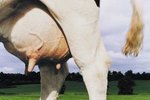
When goats reach about a year old, they're still considered physically and emotionally immature but are sexually capable of reproduction – some breeds reaching puberty as early as 4 months of age. The name "doeling" is generally applied only to immature female goats who are not yet sexually active. However, that term is casual rather than definitive, and the correct name for all female goats is doe. Calling a doe a doeling is the human equivalent of saying she's a little girl.
So You Want to Keep Goats
If you plan to keep goats, you should first decide why you want them, then explore various breeds to find a match suitable for your needs. A pet goat need not be any particular age, sex or breed, but should be healthy. The same is true for goats you intend to use for clearing brush and weeds. If you want dairy goats, look to Saanens, Alpines, Nubians, LaManchas or other traditional milkers. If you have limited space, you may want to consider Nigerian dwarf or pygmy goats, or a miniature goat breed. Remember that goat kids are among nature's cutest babies, so you need a firm resolve not to buy them merely because they're cute. If you must have kids, buy only those kids that suit your plans best before falling in love.
Assessing a Doeling
If you plan to breed goats or operate a goat dairy, look over the ancestors of prospective doelings carefully for health, confirmation of breed type and characteristics consistent with good mothering and quality milk production. Understanding what to look for in an udder is especially important. An immature doe will yield little information on this score, as her udder is unformed prior to kidding. Observing her mother, or dam, gives you a better feel for the shape her udder will take after producing kids and what sort of mother she likely will be. Good dams usually produce offspring with strong maternal instincts. The mother of your doeling's father is also important. Her udder quality influences the udder quality of her granddaughters at least as much as that of the doeling's mother. The more close relatives of a doeling you can look at, the better chance you have of choosing a quality doeling for your starter herd.
Where to Get Your Doelings
Many experts advise not buying a goat -- or any other animal for that matter -- from a “sale barn” or auction. Such places often exhibit the worst of a breeder's stock -- the sick, diseased or problem animals the breeder wishes to cull from his herd. Some may make fine pets or even scrub goats for brush-clearing duties -- assuming they're not seriously ill and lack the exemplary qualities you want in breeding stock -- but if you intend to build a quality herd, shop elsewhere. There are reputable agencies and associations in every state to help you find quality, disease-free goats. University agricultural department extension services and online goat forums are good places to start learning about goats and their care. Visit dairy shows and talk to experienced breeders to learn what to look for.
Reproduction in Doelings
You may want to breed your goats; however, when dealing with young does, it's important not to rush things. Ensure your doelings are physically fit prior to breeding. They should have adequate calories and exhibit steady weight gain for their age. Doelings will come into their first heat, or estrus, at 4 to 8 months, but should ideally not be bred until they've reached at least 60 percent of their expected adult weight. Does bred before this stage -- usually around 10 months -- will often have difficult births or may not have the resources to supply adequate milk for their kids. Many breeders wait until does are at least 18 months old before breeding.
References
Resources
Photo Credits
-
NA/AbleStock.com/Getty Images




